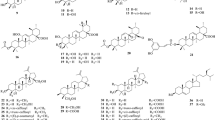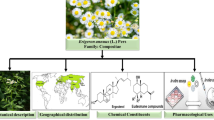Abstract
Ixora coccinea Linn., (Rubiaceae) commonly known as jungle of geranium and red ixora, is an evergreen shrub found throughout India. Depending on the medical condition, the flowers, leaves, roots, and the stem are used to treat various ailments in the Indian traditional system of medicine, the Ayurveda, and also in various folk medicines. The fruits, when fully ripe, are used as a dietary source. Phytochemical studies indicate that the plant contains important phytochemicals such as lupeol, ursolic acid, oleanolic acid, sitosterol, rutin, lecocyanadin, anthocyanins, proanthocyanidins, glycosides of kaempferol and quercetin. Pharmacological studies suggest that the plant possesses antioxidative, antibacterial, gastroprotective, hepatoprotective, antidiarrhoeal, antinociceptive, antimutagenic, antineoplastic and chemopreventive effects, thus lending scientific support to the plant’s ethnomedicinal uses. In the present review, efforts are made in addressing its ethnomedicinal uses, chemical constituents, and validated pharmacological observations.
Similar content being viewed by others
References
National Institute of Science Communication and Information Resources. Glossary of Indian medicinal plants with active principles. New Delhi 1992:374.
National Institute of Science Communication and Information Resources. The wealth of India, dictionary of Indian raw materials and industrial products—raw materials. New Delhi 2002:351.
Griffiths M. Index of garden plants. Portland: Timber Press; 1994:1234.
Liogie HA. Descriptive flora of Puerto Rico and adjacent islands. Vol. 5. Editorial de la Universidad de Puerto Rico, San Juan, Puerto Rico; 1997:436.
Idowu TO, Ogundaini AO, Salau AO, Obuotor EM, Bezabih M, Abegaz BM. Doubly linked, a-type proanthocyanidin trimer and other constituents of Ixora coccinea leaves and their antioxidant and antibacterial properties. Phytochemistry 2010;71:2092–2098.
Nazarudeen A. Nutritional composition of some lesserknown fruits used by the ethnic communities and local folks of Kerala. Indian J Tradit Knowl 2010;9:398–402.
Whistler, WA, ed. Tropical ornamentals, a guide. Portland: Timber Press; 2000:542.
Ayyanar M, Ignacimuthu S. Herbal medicines for wound healing among tribal people in Southern India: ethnobotanical and scientific evidences. Int J Appl Res Nat Prod 2009;2(3):29–42.
Latha PG, Nayar MNS, Singh OV, George V, Panikkar KR, Pushpangadan P. Isolation of antigenotoxic ursolic acid from Ixora coccinea flowers. Actual Biol 2001;23(74):21–24.
Deshpande A, Jadge D, Dhawale S, Patrakar R, Gadgul A. Flower extract of Ixora coccinea as a natural indicator in acid base titration. J Pharm Res 2010;3:2512–2513.
Annapurna J, Amarnath PV, Amar Kumar D, Ramakrishna SV, Raghavan KV. Antimicrobial activity of Ixora coccinea leaves. Fitoterapia 2003;74:291–293.
Council for Scientific and Industrial Research. The wealth of India: raw materials. Vol. V. New Delhi; 1 1959:275.
John D. One hundred useful raw drugs of Kani tribe of India. Int J Crude Drug Res 1984;22:17–39.
Kirtikar KR, Basu BD. Indian medicinal plants. Vol. 2. 2nd ed. Dehradun: International Book Publisher; 2005:1288–1289.
Batugal PA. Inventory and documentation of medicinal plants in 14 Asia Pacific countries. In: Batugal PA, Jayashree K, Lee SY, Jeffrey TO, eds. Medicinal plants research in Asia: the framework and project work plans. 1. International Plant Genetic Resources Institute—Regional Office for Asia. Serdang: The Pacific and Oceania;2004:3–6.
Saha MR, Alam MA, Akter R, Jahangir R. In-vitro free radical scavenging activity of Ixora coccinea L. Bangla J Pharmacol 2008;3:90–96.
Sankaranarayanan S, Bamal P, Ramachandran J, Kalaichelvan PT, Deccaraman M, Vijayalakshimi M, et al. Ethnobotanical study of medicinal plants used by traditional users in Villupuram district of Tamilnadu, India. J Med Plants Res 2010;4:1089–1101.
Sivarajan VV, Balachandran I. Ayurvedic drugs and their plant sources. New Delhi: Oxford and IBH Publishing Co., Ltd; 1994:347.
Sivaperumal R, Ramya S, Veera Ravi S, Rajasekaran C, Jayakumararaj R. Herbal remedies practiced by Malayali’s to treat skin diseases. Environ Int J Sci Tech 2009;4:35–44.
Vadivu N, Jayshree C, Kasthuri K, Rubhini G, Rukmankathan G. Pharmacognostical standardization of leaves of Ixora coccinea Linn. J Pharm Sci Res 2010;2:164–170.
Alia SS, Kasojua N, Luthraa A, Singha A, Sharanabasavaa H, Sahua A, et al. Indian medicinal herbs as sources of antioxidants. Food Res Int 2008;41:1–15.
Torey A, Sasidharan S, Latha LY, Sudhakaran S, Ramanathan S. Antioxidant activity and total phenolic content of methanol extracts of Ixora coccinea. Pharm Biol 2010;48:1119–1123.
Dixit Y, Kar A. Antioxidative activity of some vegetable peels determined in vitro by inducing liver lipid peroxidation. Food Res Int 2009;42:1351–1354.
Shyamal S, Latha PG, Suja SR, Shine VJ, Anuja GI, Sini S, et al. Hepatoprotective effect of three herbal extracts on aflatoxin B1-intoxicated rat liver. Singapore Med J 2010;51:326–331.
Cronstein BN, Weissmann G. Targets for antiinflammatory drugs. Annu Rev Pharmacol Toxicol 1995;35:449–462.
Evans DA, Hirsch JB, Dushenkov S. Phenolics, inflammation and nutrigenomics. J Sci Food Agric 2006;86:2503–2509.
Ratnasooriya WD, Deraniyagala SA, Galhena G, Liyanage SSP, Bathige SDNK, Jayakody JRAC. Anti-inflammatory activity of the aqueous leaf extract of Ixora coccinea. Pharm Biol 2005;432:147–152.
Handunnetti SM, Kumara RR, Deraniyagala SA, Ratnasooriya WD. Anti-inflammatory activity of Ixora coccinea methanolic leaf extract. Pharmacol Res 2009;1:80–90.
Zachariah R, Nair CR, Velayudha PP. Anti-inflammatory and anti-mitotic activities of lupeol isolated from the leaves of Ixora coccinea Linn. Indian J Pharm Sci 1994;56:129–132.
De-Sousa HF, Leite JA, Barbosa-Filho JM, Athayde-Filho PF, de Oliveira-Chaves MC, Moura MD, et al. Gastric and duodenal antiulcer activity of alkaloids: a review. Molecules 2008;13:3198–3223.
Arunachalam G, Subramanian N, Pazhani GP, Karunanithi M, Ravichandran V. Phytochemical and anti-ulcer investigations of the fresh leaf extract of Ixora coccinea Linn. (Rubiaceae) in albino rat model. Int J Pharm Sci 2009;1:26–31.
World Health Organization. World Health Report. Geneva; 2004:120–125. Available from URL: http://www.who.int/whr/2004/en/
Yasmeen M, Prabhu B, Agashikar NV. Evaluation of antidiarrhoeal activity of leaves of Ixora coccinea Linn in rats. J Clin Diagn Res 2010;4:3298–3303.
Ratnasooriya WD, Deraniyagala SA, Bathige SD, Goonasekara CL, Jayakody JR. Antinociceptive action of aqueous extract of the leaves of Ixora coccinea. Acta Biol Hung 2005;56:21–34.
Maron DM, Ames BN. Revised methods for the Salmonella mutagenicity test. Mutation Res 1983;113:173–215.
Ferguson LR. Antimutagens as cancer chemopreventive agents in diet. Mutation Res 1994;307:395–410.
Butz P, Edenharder R, Fister H, Tauscher H. The influence of high pressure processing on antimutagenic activities of fruit and vegetable juices. Food Res Int 1997;30:287–291.
Ferguson LR, Philpott M, Karunasinghe N. Dietary cancer and prevention using antimutagens. Toxicology 2004;20:147–59.
Wongwattanasathien O, Kangsadalampai K, Tongyonk L. Antimutagenicity of some flowers grown in Thailand. Food Chem Toxicol 2010;48:1045–1051.
Aggarwal BB, van Kuiken ME, Iyer LH, Harikumar KB, Sung B. Molecular targets of nutraceuticals derived from dietary spices: potential role in suppression of inflammation and tumorigenesis. Exp Biol Med 2009;234:825–849.
Dorr RT, Fritz W. Cancer chemotherapy handbook. New York and Oxford: Elsevier; 1980.
Latha PG, Panikkar KR. Cytotoxic and antitumor principles from Ixora coccinea flowers. Cancer Lett 1998;130:197–202.
Coleman CN, Bump EA, Kramer RA. Chemical modifiers of cancer treatment. J Clin Oncol 6:709–733.
Latha PG, Panikkar KR. Modulatory effects of Ixora coccinea flower on cyclophosphamide-induced toxicity in mice. Phytother Res 1999;13:517–520.
Latha PG, Panikkar KR. Chemoprotective effect of Ixora coccinea L. flowers on cisplatin induced toxicity in mice. Phytother Res 2001;15:364–366.
Guilford JM, Pezzuto JM. Natural products as inhibitors of carcinogenesis. Exp Opi Inv Drugs 2008;17:1341–1352.
Latha PG, Panikkar KR. Inhibition of chemical carcinogenesis in mice by Ixora coccinea flowers. Pharm Biol 2000;38:152–156.
Author information
Authors and Affiliations
Corresponding author
Rights and permissions
About this article
Cite this article
Baliga, M.S., Kurian, P.J. Ixora coccinea Linn.: Traditional uses, phytochemistry and pharmacology. Chin. J. Integr. Med. 18, 72–79 (2012). https://doi.org/10.1007/s11655-011-0881-3
Received:
Published:
Issue Date:
DOI: https://doi.org/10.1007/s11655-011-0881-3




